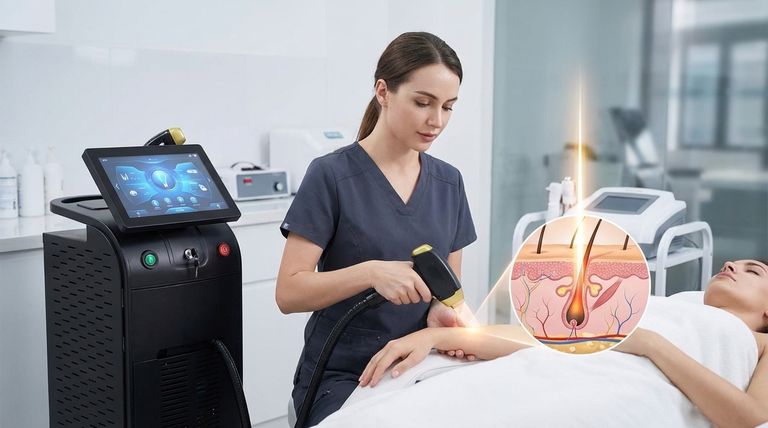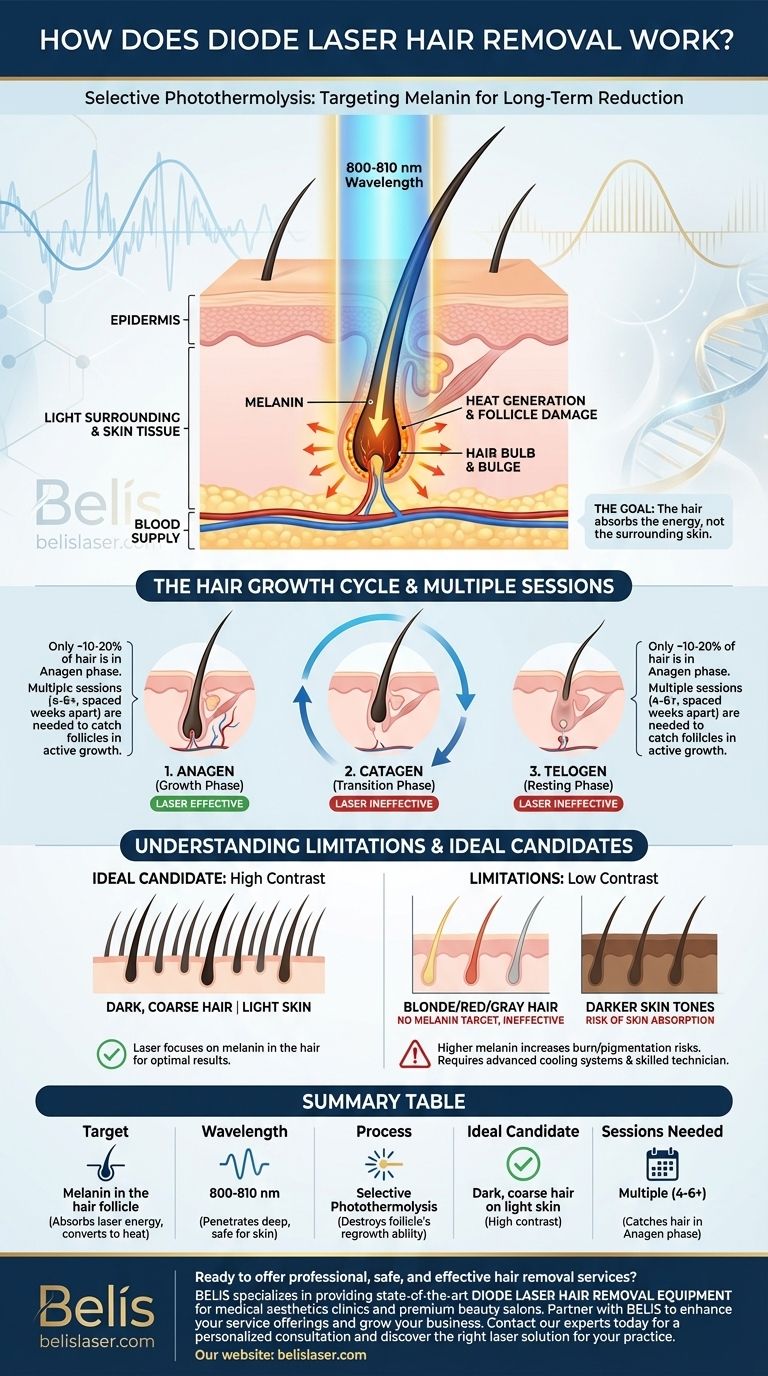At its core, diode laser hair removal works by using a concentrated beam of light to target and destroy the pigment (melanin) within the hair follicle. This principle, called selective photothermolysis, involves generating intense heat that damages the follicle's ability to regrow hair, all while leaving the surrounding skin tissue unharmed. The process is precise, targeting only the structures responsible for hair growth.
Diode laser hair removal is not a surface-level treatment; it's a medical process that targets the root cause of hair growth. Its success depends entirely on the laser's ability to "see" the pigment in the hair follicle, which is why it is most effective during a specific phase of the hair's growth cycle.

The Science of Selective Destruction
To understand how a diode laser removes hair, you must first understand its target. The entire process is designed to deliver a precise dose of energy to a specific component压力 of the hair follicle without damaging the skin.
The Role of the Laser's Wavelength
Diode lasers typically operate at a wavelength of 800-810 nanometers (nm). This specific wavelength is a "sweet spot" because it penetrates deep into the skin to reach the hair follicle while being highly absorbed by melanin.
Melanin: The Target Chromophore
Melanin is the pigment that gives your hair (and skin) its color. During laser treatment, the melanin in the hair shaft and follicle acts like a lightning rod, absorbing the laser's light energy.
This focused absorption is what makes the process "selective." The goal is for the hair to absorb the energy, not the surrounding skin.
The Heating and Destruction Process
When melanin absorbs the laser's energy, that light energy is instantly converted into intense heat. This heat radiates outwards, damaging the key structures within the follicle responsible for hair growth, such as the hair bulb and bulge.
This thermal damage disrupts the blood supply to the follicle and disables its ability to produce a new hair. The treated hair will eventually shed, and the follicle will, ideally, be unable to regenerate.
Why Multiple Sessions Are Necessary
A common point of confusion is why one session isn't enough. The effectiveness of laser hair removal is entirely dependent on the hair's natural growth cycle, which occurs in three phases.
Anagen (The Growth Phase)
This is the only phase where the laser is effective. During the anagen phase, the hair is actively growing and is firmly attached to the papilla (the base of the follicle), which provides its blood supply.
The laser needs this connection to effectively transfer jego thermal energy to the follicle's regenerative structures.
Catagen (The Transition Phase)
In this short phase, the hair detaches from the papilla and stops growing. Because a physical connection to the follicle's base is lost, the laser cannot effectively transfer heat to disable it.
Telogen (The Resting Phase)
During the telogen phase, the hair is dormant and is waiting to be shed. The follicle itself is inactive, making laser treatment completely ineffective.
Because only a fraction of your hair (typically 10-20%) is in the anagen phase at any given time, treatments must be spaced several weeks apart to catch the next wave of follicles as they enter the growth phase.
Understanding the Trade-offs and Limitations
Diode laser hair removal is a powerful tool, but it is not a universal solution. Its effectiveness is dictated by physics and biology, which creates clear limitations.
The Importance of Contrast
The ideal scenario for diode laser hair removal is high contrast: dark, coarse hair on light skin. This allows the laser to focus its energy on the melanin in the hair follicle with minimal absorption by the melanin in the surrounding skin.
Ineffectiveness on Light Hair
The treatment is ineffective on blonde, red, white, or gray hair. These hair colors lack sufficient melanin to absorb the laser's energy, meaning there is no target for the laser to heat and destroy.
Risks for Darker Skin Tones
Higher concentrations of melanin in the skin (as in darker skin tones) increase the risk that the laser will be absorbed by the skin itself, not just the hair. This can lead to burns, blisters, or changes in skin pigmentation (hyper- or hypopigmentation).
Modern diode lasers often include advanced cooling systems and longer pulse durations to mitigate these risks, but a skilled, experienced technician is crucial for safely treating darker skin.
Making the Right Choice for Your Goal
Whether this treatment is right for you depends on your specific hair and skin combinação.
- If your primary focus is treating dark, coarse hair on light to medium skin: Diode lasers are considered a gold standard, offering an efficient and highly effective path to long-term hair reduction.
- If you have blonde, gray, or red hair: This method will be ineffective because it relies on melanin as a target, which your hair lacks.
- If you have a darker skin tone: You must seek a provider with specific experience and a laser system (like a diode or Nd:YAG) equipped with safety features for your skin type to minimize risk.
Understanding the science of how diode lasers target the hair follicle empowers you to make an informed decision for your specific skin and hair type.
Summary Table:
| Key Aspect | How it Works | Why it Matters |
|---|---|---|
| Target | Melanin in the hair follicle | Melanin absorbs laser energy, which is converted to heat. |
| Wavelength | 800-810 nm | Penetrates deep to reach the follicle while being safe for skin. |
| Process | Selective Photothermolysis | Destroys the follicle's ability to regrow hair without damaging skin. |
| Ideal Candidate | Dark, coarse hair on light skin | High contrast allows laser to focus energy on the hair, not the skin. |
| Sessions Needed | Multiple (4-6+), spaced weeks apart | Catches hair in the active growth phase (Anagen). |
Ready to offer professional, safe, and effective hair removal services?
BELIS specializes in providing state-of-the-art diode laser hair removal equipment for medical aesthetics clinics and premium beauty salons. Our advanced systems are designed for optimal performance across a range of skin types, helping you deliver superior results to your clients.
Partner with BELIS to enhance your service offerings and grow your business.
Contact our experts today for a personalized consultation and discover the right laser solution for your practice.
Visual Guide

Related Products
- Clinic Diode Laser Hair Removal Machine with SHR and Trilaser Technology
- Diode Laser SHR Trilaser Hair Removal Machine for Clinic Use
- Diode Tri Laser Hair Removal Machine for Clinic Use
- Trilaser Diode Hair Removal Machine for Beauty Clinic Use
- Clinic Use IPL and SHR Hair Removal Machine with Nd Yag Laser Tattoo Removal
People Also Ask
- Is diode laser effective for hair removal? Achieve Long-Term Hair Reduction with Gold Standard Tech
- What is better, an IPL or a diode laser? Choose the Right Tool for Your Aesthetic Goals
- Can you use laser hair removal on intimate areas? Achieve Lasting Smoothness and Comfort
- What is the most effective laser hair removal method? Find the Perfect Match for Your Skin & Hair
- Which is more effective, diode or IPL? The Definitive Answer for Permanent Hair Reduction



















